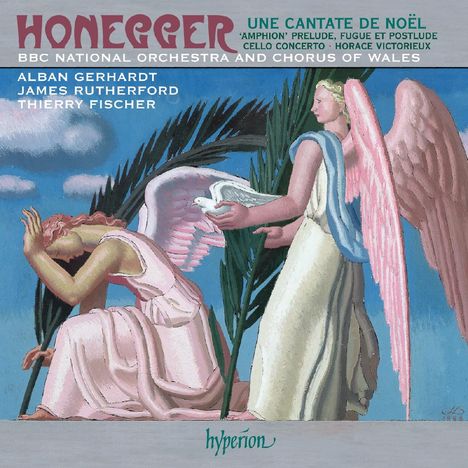Arthur Honegger: Une Cantate de Noel "Weihnachtskantate" auf CD
Une Cantate de Noel "Weihnachtskantate"
Herkömmliche CD, die mit allen CD-Playern und Computerlaufwerken, aber auch mit den meisten SACD- oder Multiplayern abspielbar ist.
Lassen Sie sich über unseren eCourier benachrichtigen, falls das Produkt bestellt werden kann.
+Horace victorieux; Cellokonzert; Prelude, Fugue et Postlude aus "Amphion"
- Künstler:
- Alban Gerhardt, James Rutherford, BBC National Chorus of Wales, BBC National Orchestra of Wales, Thierry Fischer
- Label:
- Hyperion
- Aufnahmejahr ca.:
- 2008
- UPC/EAN:
- 0034571176888
- Erscheinungstermin:
- 21.11.2008
Ähnliche Artikel
Honeggers Weihnachtskantate
Arthur Honegger schrieb »Une Cantate de Noël« – sein zugleich letztes Werk – im Jahr 1953. Die Kantate ist für gemischten Chor, Bariton-Solo, Orgel und Orchester sowie einen kleinen Kinderchor komponiert und behandelt die biblische Weihnachtsgeschichte. Abgerundet wird das vorliegende Programm durch eine Auswahl großer Orchesterwerke Honeggers. Alban Gerhardt brilliert hier als Solist mit einem überlegenen Spiel, bei dem sich Talent mit Phantasie und stupender Musikalität verbinden. Er weiß sich gekonnt mit flinkem Bogen und rasenden Fingern in Szene zu setzen, ohne effekthascherisch oder manieriert zu wirken.
Product-Information:
Honegger’s Une Cantate de Noël is a Christmas number with a difference. His last work and one of his most popular compositions, it was written for the Basle Chamber Choir and Orchestra in 1953. The text of the cantata is derived from liturgical and popular texts—including Psalms and part of the Latin Gloria. A notable feature is the intertwining of traditional carols in French and German: appropriate for multilingual Switzerland and also perhaps symbolizing peace among nations seven years after the conclusion of World War II. Honegger scored the cantata for solo baritone, mixed chorus, children’s choir and an orchestra including organ. The combination of the different texts and forms creates a wonderfully uplifting effect.
This recording from the BBC National Orchestra of Wales under Thierry Fischer also includes a selection of Honegger’s other great orchestral works, all displaying the serious symphonic intent which marked his greatest compositional achievements. Horace victorieux is described as a Symphonie mimée d’apres Tite-Live (‘mimed symphony after Livy’) and was originally conceived as a ballet. The scenario derives from the Roman legend of the combat of the Horatii and the Curiatii. Scored for a large orchestra, it is flamboyant, dissonant, even raucous, and highly coloured. Honegger’s mastery of fugue, so prevalent in Horace victorieux, is further illustrated in his Prélude, Fugue et Postlude.
Honegger’s Cello Concerto was premiered in Boston in 1930 and is a charming, urbanely lyrical work, with a distinct tinge of jazz—perhaps actuated by the thought of the American premiere. It was written for the celebrated cellist Maurice Maréchal, who wrote the cadenza himself. In the event, Maréchal provided a brilliantly effective display-piece taking advantage of many of the outrageous aspects of virtuoso cello technique (notably majestic triple- and quadruple-stopping). The brilliant young cellist Alban Gerhardt, celebrated for his performances of little-known cello concertos in Hyperion’s Romantic Cello Concerto series, is the soloist.
Rezensionen
'Fischer directs controlled but expressive accounts of all four works which would grace any collector's shelves' (Gramophone)
'If Santa can only bring you one present this Christmas, make it the Hyperion recording of Honegger's Une Cantate de Noel' (Birmingham Post)
'This superbly recorded release significantly adds to the Honegger discography. Despite giving top billing to “Une Cantate de Noël”, all four works here are of the highest level of craftsmanship' (ClassicalSource. com)
'This gleaming new recording … The Cello Concerto is a debonair score with a bluesy turn-of-phrase that suggests Honegger was spinning Duke Ellington records on his turntable. Gerhardt plays with genuine soul' (Classic FM Magazine)
Rezensionen
FonoForum 02/09: "Dieses hervorragend zusammengestellte Programm berührt fast alle musikalischen Ausdrucksbereiche Honeggers. Sie führen vom schroffen Avantgardismus über Anklänge an den Jazz bis hin zu resignativer Kontemplation. Die bestechenden Interpretationen werden nicht bloß allen Ausdrucksbereichen gerecht, sondern werben schlechterdings bezwingend für diesen vernachlässigten Komponisten. Alban Gerhardts Aufnahme des Cellokonzertes zeigt sich nicht nur der Referenz-Aufnahme durch Rostropowitsch gewachsen, sondern löst sie ab!"Disk 1 von 1 (CD)
Horace Victorieux (1921) (Symphonie Mimée)
-
1 1. Satz: Anime
-
2 2. Satz: Camille et Curiace
-
3 3. Satz: Entree des Horaces
-
4 4. Satz: Entree de la foule precedant les Heros
-
5 5. Satz: Annonce et preparatifs du Combat
-
6 6. Satz: Le Combat
-
7 7. Satz: Triomphe d#Horace
-
8 8. Satz: Lamentations et imprecations de Camille
-
9 9. Satz: Meurtre de Camille
Konzert für Violoncello und Orchester (1929)
-
10 1. Satz: Andante
-
11 2. Satz: Lento
-
12 3. Satz: Allegro marcato - Lento - Presto
Prélude, Fugue et Postlude
-
13 Präludium
-
14 Fuge
-
15 Postludium
Une Cantate de Noël (1953)
-
16 Teil 1
-
17 Teil 2








